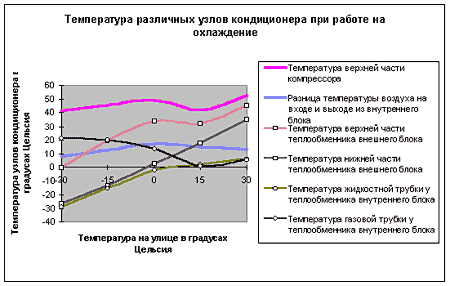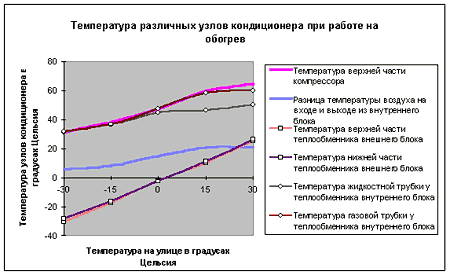

| NEWS | |||||||
| ABOUT | |||||||
| PRODUCTS AND SERVICES | |||||||
|
| |||||||
| PLACE AN ORDER | |||||||
| DOWNLOAD | |||||||
| HELPFUL HINTS | |||||||
| FAQ | |||||||
| LINKS | |||||||
| SEARCH | |||||||
| SITE MAP | |||||||
| CONTACT | |||||||
| русский |
HELPFUL HINTSSplit-system's operation when the temperature is below zero.If one will compare a climatic map of a world with a diagram, which reflects the quantity of a selling conditioners it is easy to come to conclusion that in the regions with a cold winter not more than 0,5% of all climatic equipment is setting down.And really, in countries which are using the lion's share of split-systems even in January a column of thermometer is rarely lowing below +3-9°C. That is why it is no wonder that the majority of the companies, producing conditioners do not examine them in conditions of low temperatures Such lots of technical catalogues of the leading Japanese manufactures include the information about the operation of split-system in a heating mode up to 8-9°C. It is interesting but this coincides exactly with an absolute minor temperature, fixed in Tokyo. And when an operation of the same conditioners in a cooling mode, usually the characteristics in a range from +10 -20 till +43°C are given. Meanwhile the exploitation experience of some Japanese and European equipment in the severe Russian conditions shows that they are also efficient enough under the low temperatures. This is important because rather often the necessity to condense a premise, full of computers, step-and-repeat machines and other heat-matriculation-equipment appears. Table 1 . Conditioners with thermocompressor
In this case it is necessary to cool perennially, and it is not advisable to use conditioners of a "Close control" type due to purely economic reasons. To regulate the temperature, while giving cold street air is not always advisable as well, as it is too dry. This influences negatively the difficult electronic, bringing the quick insiccation of the insulation finishes with all following consequences. Due to this reason in winter they often use split-systems, which produce a humidity less than 30%. But the selection of this equipment often is done by eye, with twice-thrice-repeated exceeding of cooling capacity over the existing heat matriculations. Not having the exact information about lowness of cold-productivity in conditions of temperatures below zero one has to insure, putting in project more powerful and more expensive equipment. Significant exceeding of required power is not good because it brings to a quick deterioration of a conditioner, due to more frequent switching on and off. Due to understandable reasons it is especially dangerous for the bucket compressors in winter, when each unnecessary start of not-warmed-up compressor shortens its service life. Knowing the parameters of cooling conditioner's operation in conditions of low temperatures, it is possible to avoid such problems. In particular this allows to make a special adaptation of a conditioner to the operation in winter conditions (low-temperature performance). For cold-productivity to stay at a level close to a nominal one, it is necessary to regulate the pressure of condensation. And for a switching on of the compressor in a smoother way, it is foreseen the heating of the oil in its banjo at least up to +10°C. Experience shows that in order to achieve this aim a grill with a power 25-30 W is enough. Cooling in winter can be needed not only for the computer halls though. Rather often it happens that a system of central heating creates surplus heats in a premise. "Window leaf's" regulation of the temperature in this case is not always acceptable, as matriculation of big amount of the air from a street can low up humidity till not comfortable one. Children are specially sensitive to this, their skin is withering because of a low humidity, and in some cases epistaxis appears. If due to some reasons installation of thermoregulator is not possible, the system of conditioning - is the way out. But more often an operation of a heating system causes the blames because of the tardy switching on/off and not high enough temperature of heat-transfer. In a country, where the heating period lasts 7-8 months per year, a possibility to warm up near a conditioner when the temperature is less than 5-10°C is important for many people. So, what happens when a conditioner operates in conditions of low temperatures. Information concerning various units of split-system in the temperature range of outside air from -30 till +30°C can be seen in the diagrams 1 and 2.
The given diagrams give some "food for thoughts". Even when the temperature of outside air is -30°C, the temperature of the compressor is not lowing down +30°C, i.e. it will heat up itself. Just because of this the warming of banjo is necessary only when a starting of the operation. This also explains why when switching on when the temperature is -20°C a conditioner continues to operate even when the temperature is lowing down till the mark -30°C. At the same time the attempt to switch on "not warmed-up" compressor when the temperature is -30°C can be done in vain. Low productivity of the conditioners, operating for a warm when the negative temperatures explains
the fact that in the countries with cool winter warming conditioners practically are not used.
This is brightly described in a table №1.
And really in Mediterranean and in populous Japanese regions the air temperature is lowing down +5°С very rarely. That is why the heating systems are not provided and one can warm himself/herself up thanks to a conditioner during one-two cool weeks. But in this time in a comparatively cool Germany where the heating period usually lasts 2-3 moths they consider that to heat the premises with the help of air conditioners is a profusion. It is cheaper to use simple oil radiator or a small stove. So the conclusion is that in Russian conditions as well it is advisable to switch a conditioner in a heating mode only in autumn and in spring, when the heating is not operating yet or already, and it is cold in a street. And even summer at our latitudes can be so that in August the warm is desirable already. |

